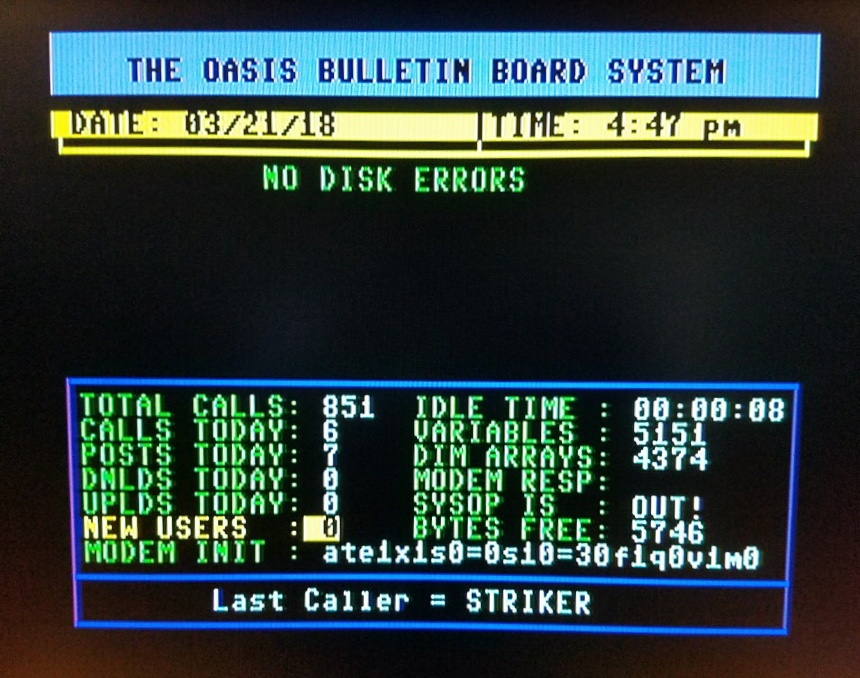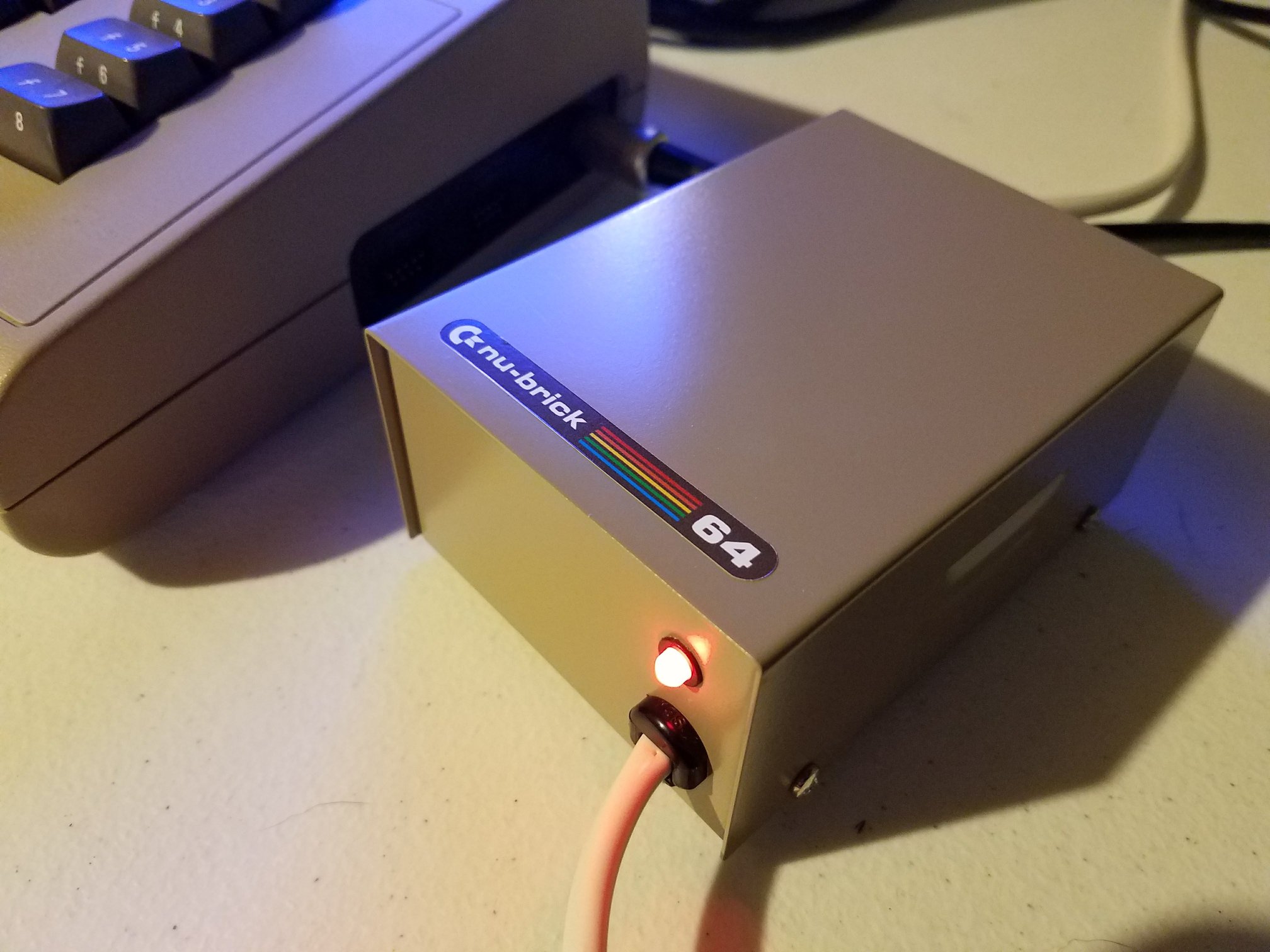There has been considerable talk on The Oasis BBS about SCSI2SD. I am interested in hearing about this as I have a Lt. Kernal and a Thunderdrive. The Ltk is over 30 years old and I would like to have an option to have a back up system in place. Can someone take a moment and explain it's setup and use? I would love to hear about it.
Well, I ran my BBS first time around from 2005-2010 via telnet. Was using a physical hard drive in my Lt. Kernal. Started out with a 105meg Quantum. After some time it started making some weird clicking noises, and I eventually ended up replacing it with a 2.1gig Seagate. Since Lt. Kernal only can use up to 160meg, I edited my Sysgen disk to only use 160 meg of the drive. I eventually added a second Seagate drive which was exact same drive as first, and had total of 320meg available for the BBS. I was doing backups of the main files with a 1581 drive and a large stack of 3.5" floppies. Did not have patience to backup all of the file transfer areas. I took the BBS down due to lack of activity.
In 2019, got the bug and tried to resurrect the BBS. When fired everything up, both the 2.1gig Seagate main drive and the 2nd drive would not spin up either. Had to smack first drive a few times to get it to spin up. Never was able to get 2nd drive to spin. When tried to copy files off it, there were many corrupt files. I still had 2 sets of 1581 backup disks from before I took the BBS down. I had several corrupt files on the 1581 disks, and even a couple disks that were unreadable. From what I could salvage and modding a few files from original Centipede BBS disks, I was able to get the BBS back online.
It got me thinking, I had to find an efficient way to backup the BBS before I advertised it as ready for prime time. I read about few people that were able to use a SCSI2SD device on their CMD hard drives. Could not find anything about anyone using it on an Lt Kernal. So figured I would get one and give it a shot.
I purchased a SCSI2SD v5.1 from Inertial Computing. After quite a bit of trial and error, I was able to get the device setup with an 8gig SD card (yes, overkill) and configured it as 2 160meg drives. I edited the Sysgen hard drive parameters, ran it, and now have a dual drive Lt Kernal setup using a single SCSI2SD device. Setup the Lt Kernal to maximize use of the 320meg. Copied all the files over to it, and then advertised that my BBS was back online.
The BBS has been running 24/7 on the SCSI2SD for over 2 1/2 years now. Have not had a single problem related to the SCSI2SD. I use Win32 Disk Imager on a PC to backup an image of the SD card. I can backup my entire BBS in less than 7 minutes. I purchased 10 of the exact same SD cards in case something went bad and had to restore from an image. I have restored from an image more than once and everything worked perfectly.
PC will not read files from the SD card as the Lt Kernal uses a custom file system that the PC won't recognize. I have a 3rd C128 system setup on the BBS with multiple drives that I can extract individual files when needed.
I'll post more info on how I configured the SCSI2SD and the Lt Kernal later.
I purchased a SCSI2SD v5.1 from Inertial Computing.
Looks like they're up to v5.5 now.
https://store.inertialcomputing.com/product-p/scsi2sd-v5.5.htm
Unfortunately it's out of stock.
I was just out at https://scsi2sd.com and I see they have a Version 6 now. It seems as though there is a supply shortage...yet again
The v5.5 is to be used as a stand alone external device. Unfortunately the Lt Kernal does not use a standard SCSI pinout so plugging it into the host adapter could damage it.
I use the v5.1, mounted it in an original Lt Kernal case and connected it to the custom 50-pin to 25-pin board inside the case. I do have a v5.2 as well and it works just like the v5.1 board.
I see that all are out of stock except for a new ZuluSCSI board. Might have to get one to try it out.
I edited the Sysgen disk for 2 drives. Both are setup with same parameters.
| LTK Config | |
| 128 | BIT 7="N" embedded controller |
| 0 | Step Period |
| 255 | Sectors/Track |
| 1 | Number of Heads |
| 4 | Number of Cylinders - High Byte |
| 218 | Number of Cylinders - Low Byte |
| 0 | Write precomp Cylinders |
| 0 | unknown, but is ZERO on all (spare?) |
Finally, here is how I setup the LU's.
| LU number | Starting Cylinder # | # Cylinder Size | SCSI Drive # | |
| 10 (DOS) | 0 | 8 | 8 | 0 |
| 0 | 10 | 258 | 268 | 0 |
| 1 | 268 | 243 | 511 | 0 |
| 2 | 511 | 243 | 754 | 0 |
| 3 | 754 | 243 | 997 | 0 |
| 4 | 997 | 243 | 1240 | 0 |
| 5 | 0 | 243 | 243 | 1 |
| 6 | 243 | 243 | 486 | 1 |
| 7 | 486 | 243 | 729 | 1 |
| 8 | 729 | 243 | 972 | 1 |
| 9 | 972 | 243 | 1215 | 1 |
So, I could get a couple of SCSI2SD cards. My Ltk is a split system. 2 boxes each with an 80 meg drive. Originally ,it was an 80 meg setup with two 40 meg drives. I could follow your directions above (configuring them on a PC) and have them set to go if for some reason I had a drive or drives go bad. If that is the case, it would be worth the expense to have the backup.
Nice thing about the SCSI2SD, or even the ZuluSCSI. You can configure up to 7 drives (SCSI ID#0-6) on a single SD card. With the Lt. Kernal though, 2 drives at 170meg apiece is the limit for the unit. One case, one unit, up to 7 drives, no complaints here.


![][avok - Facebook ][avok - Facebook](https://theoasisbbs.com/wp-content/plugins/wpforo/assets/images/sn/facebook.png)
![][avok - X.com ][avok - X.com](https://theoasisbbs.com/wp-content/plugins/wpforo/assets/images/sn/twitter.png)










